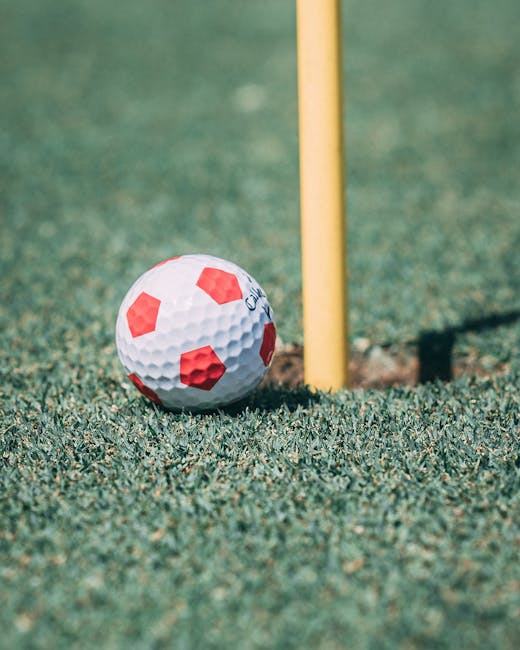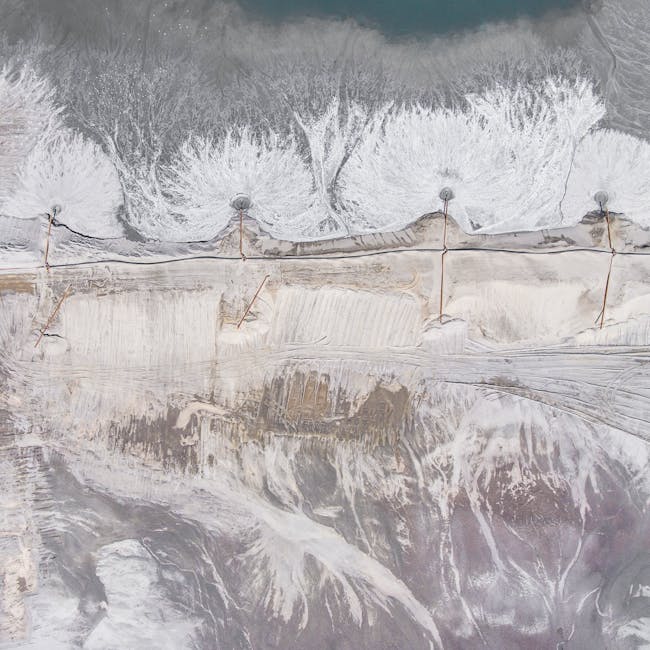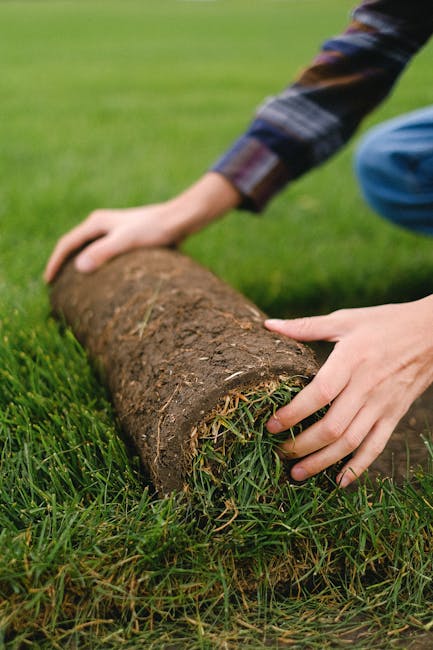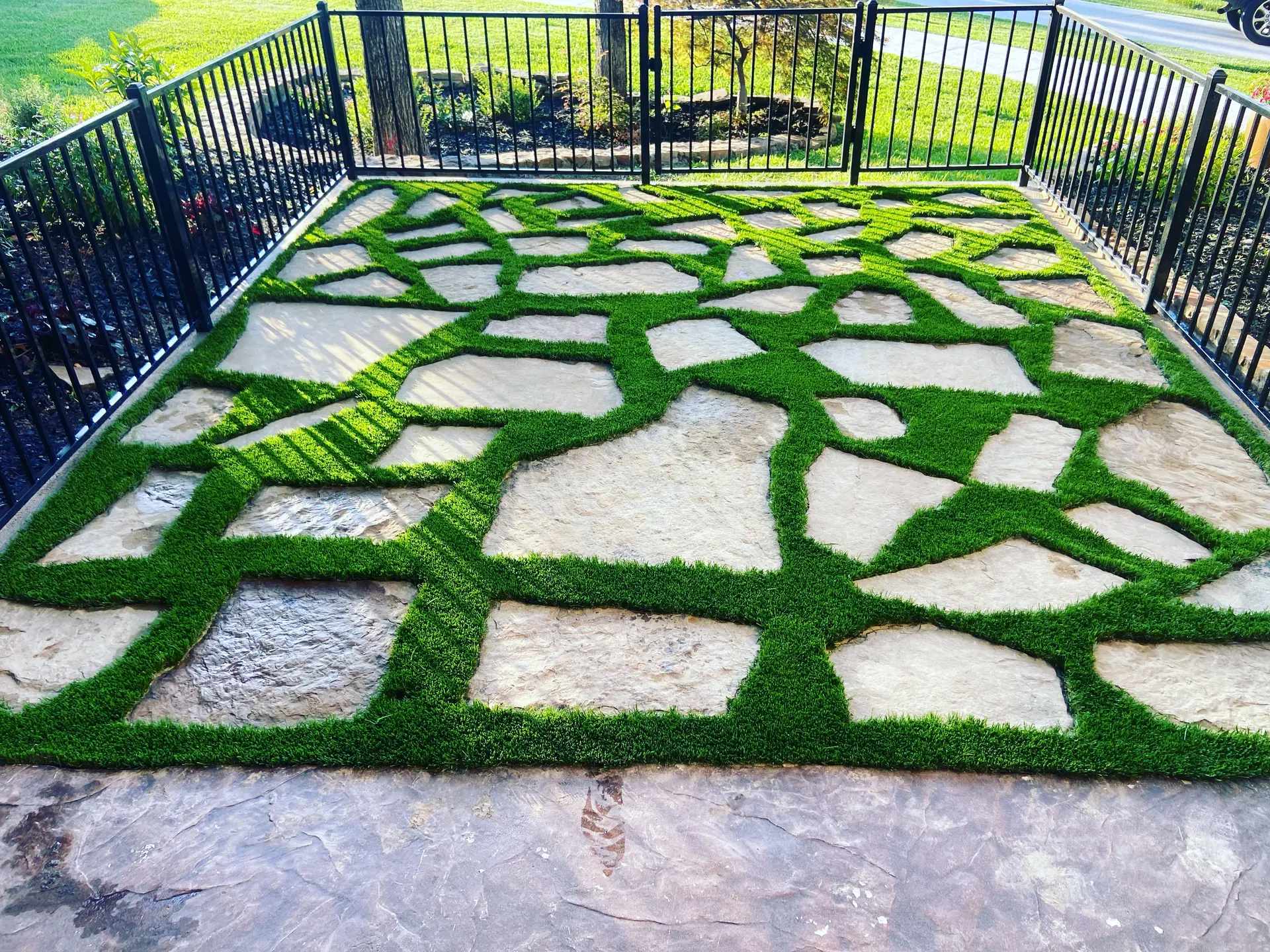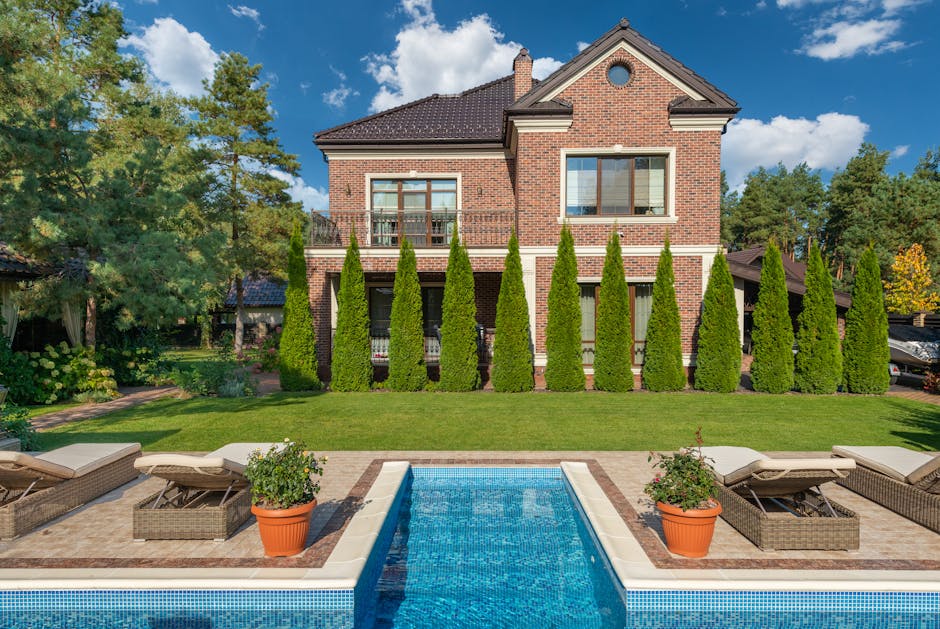
Introduction to Custom Artificial Turf Designs
In recent years, the popularity of artificial turf has surged, particularly in residential backyards. This synthetic grass alternative provides a number of practical advantages over natural lawns, which can often be high maintenance and water-intensive. Custom artificial turf designs have taken this trend to the next level, allowing homeowners to not only reduce upkeep but also enhance the aesthetic and recreational value of their outdoor spaces.
Understanding Artificial Turf
Artificial turf, also known as synthetic grass, is made from synthetic fibers that are designed to look and feel like natural grass. The primary materials used include polyethylene, polypropylene, and nylon, with each offering distinct characteristics in terms of durability, texture, and appearance.
The history of artificial turf dates back to the 1960s, where it was first used in sports stadiums. Since then, advancements in technology have significantly improved its look and feel, making it a viable option for residential landscapes. Today’s artificial turf mimics the natural grass in a convincing way while offering several practical benefits.
Components of Custom Artificial Turf Designs
Custom artificial turf designs for residential backyards typically involve several components:
- Base Layer: This is the foundational layer that provides stability and drainage. It is usually composed of compacted gravel and sand.
- Primary Turf: The main synthetic grass layer that emulates the appearance of natural grass. It includes backing materials and synthetic fibers.
- Infill: A layer added to the surface of the primary turf to provide cushioning and support. Common infill materials include sand and rubber granules.
- Edging: Borders used to delineate the turf area and prevent fraying. Popular materials for edging include metal, plastic, and brick.
Table: Key Materials and Their Characteristics
| Material | Characteristics |
|---|---|
| Polyethylene | Soft, durable, natural look |
| Polypropylene | Economical, durable, slightly rougher feel |
| Nylon | Very durable, heat resistant, realistic appearance |
| Rubber Granules (Infill) | Provides cushioning, helps with drainage |
| Sand (Infill) | Affordable, provides stable base |
By carefully selecting and combining these materials, homeowners can create a custom artificial turf design that fits their specific needs and preferences. This not only enhances the visual appeal of the backyard but also provides a durable and functional space for various activities.
Environmental and Economic Benefits
Environmental and Economic Benefits
The transformation of residential backyards with custom artificial turf designs brings significant environmental and economic advantages. These benefits encourage homeowners to choose artificial turf over natural grass, contributing positively to both their surroundings and finances.
Environmental Benefits
Water Conservation: One of the most substantial environmental benefits of artificial turf is its ability to conserve water. Traditional lawns require substantial amounts of water to remain green and healthy. According to the Environmental Protection Agency (EPA), the average American family uses 320 gallons of water per day, with about 30% devoted to outdoor uses. In dry climates, a majority of this outdoor use is for lawns and gardens. Artificial turf eliminates the need for watering, saving thousands of gallons of water annually.
Reduction of Pesticide and Fertilizer Use: Natural lawns often require pesticides and fertilizers to maintain their appearance and health. The runoff from these chemicals can have detrimental effects on the environment, contaminating local water supplies and harming wildlife. Artificial turf does not require chemical treatments, thereby reducing the environmental footprint.
Decrease in Carbon Emissions: Maintaining a natural lawn usually involves the use of gas-powered lawn mowers and other equipment, contributing to carbon emissions. By switching to artificial turf, homeowners can significantly reduce these emissions, as the artificial landscape does not require regular mowing or maintenance with power equipment.
Economic Benefits
Cost Savings: Although the initial installation of artificial turf can be higher compared to seeding or sodding a natural lawn, the long-term cost savings are significant. The expenses associated with watering, fertilizing, mowing, and general lawn maintenance are eliminated. Over time, these savings can offset the initial investment in artificial turf.
Increased Property Value: Well-maintained landscapes are known to increase property values. According to a report by the National Association of Realtors, homes with quality landscaping can see an increase in value by up to 10%. Artificial turf, with its year-round pristine appearance, can enhance curb appeal and potentially increase the market value of properties.
| Aspect | Natural Grass | Artificial Turf |
|---|---|---|
| Water Usage | High | Low |
| Pesticide & Fertilizer Use | High | None |
| Maintenance Costs | High | Low |
| Carbon Emissions | High | Low |
In conclusion, the shift to custom artificial turf designs for residential backyards offers a range of environmental and economic benefits. These advantages make it an appealing option for homeowners looking to create sustainable and cost-efficient outdoor spaces.
Design Options and Trends
Custom artificial turf designs offer a variety of options and follow several trends to meet different aesthetic and functional needs of residential backyards. The versatility of artificial turf allows homeowners to create personalized spaces that enhance both appearance and usability.
Design Options:
Artificial turf is available in different shades of green, pile heights, and textures, allowing for customizable aesthetics. Homeowners can choose from:
- Color Variations: Options include shades ranging from dark green to olive, which can imitate various types of natural grass.
- Pile Height: The length of the blades of grass can vary, typically ranging from 1 to 2.5 inches. Higher pile heights create a lush feel, while shorter ones offer a well-manicured look.
- Textures: Different fiber technologies can mimic the texture of various grasses, such as Bermuda, St. Augustine, or Fescue.
Trends in Artificial Turf Design:
Recent trends in artificial turf design include:
- Mixed Use Spaces: Combining different pile heights and textures to create diverse zones within the same backyard. For instance, shorter blades for play areas and longer blades for lounging spaces.
- Incorporating Hardscapes: Integrating artificial turf with stone, pavers, and other hardscape elements to create visually appealing and functional landscapes.
- Creative Shapes: Designing non-linear, organic shapes that blend seamlessly with natural elements in the yard.
- Sustainable Choices: Utilizing eco-friendly materials for the turf filaments and backing, to reduce environmental impact.
Popular Design Combinations:
Homeowners often choose specific design combinations based on their needs and preferences. Below is a table illustrating some popular design combinations:
| Design Element | Popular Combinations |
| Color | Emerald Green with Olive Tones |
| Pile Height | 1.5 inches for Low-Maintenance Yards, 2 inches for Luxury Lawns |
| Texture | Wavy Blades for Natural Look, Straight Blades for Modern Aesthetics |
| Hardscaping | Integrated with Stone Pathways, Surrounding Pools |
These design options and trends provide numerous avenues for homeowners to transform their residential backyards with custom artificial turf that not only enhances aesthetic value but also maximizes recreational potential.
Installation Process and Best Practices
Installing custom artificial turf in residential backyards involves a comprehensive process that ensures longevity, aesthetic quality, and optimal performance. Adhering to best practices during installation is essential to maximize the benefits of artificial turf.
Site Preparation
Site evaluation: The first step involves assessing the area to be covered. This includes measuring dimensions and identifying any potential obstacles such as trees, rocks, or irrigation systems.
Clearing the area: All existing vegetation, debris, and obstructions must be removed. This task often requires the use of specialized equipment like sod cutters and hand tools for a thorough clearing.
Grading and drainage: Proper grading is essential to prevent water accumulation. The installation site should be slightly sloped or have a drainage system in place to allow water to flow away from the turf.
Base Installation
Sub-base preparation: A compacted sub-base is critical for stability. Typically, materials like crushed rock, decomposed granite, or gravel are used. The sub-base should be leveled and compacted to a depth of 3-4 inches.
Compaction: Using a plate compactor, the sub-base is compacted multiple times to ensure a solid foundation. This step helps prevent any future shifting or settling of the turf.
Weed barrier installation: A geo-textile fabric or weed barrier is placed over the compacted base to prevent weed growth and provide additional stability.
Turf Installation
Unrolling and cutting the turf: The artificial turf is unrolled over the prepared base. Precision is key when cutting, ensuring an exact fit for the designated area. Specialized turf knives are used to make clean cuts.
Seaming: To join multiple pieces of turf, seaming tape and adhesive are applied underneath the cuts. This creates a seamless appearance and maintains the integrity of the installation.
Securing the turf: Turf is anchored using landscape stakes or nails around the perimeter. This step prevents movement and enhances structural integrity.
Infill Application
Selection of infill materials: Common infill materials include silica sand, rubber granules, or a combination of both. The choice of infill impacts factors like cushioning, drainage, and temperature regulation.
Application process: Infill is distributed evenly across the turf surface using spreaders. It is then brushed into the fibers to encourage standing, natural-looking blades.
Brushing and final touches: Power brooms or manual rakes are used to brush the turf, ensuring that the infill settles and the fibers stand upright. This process enhances the appearance and functionality of the turf.
Adhering to these best practices during the installation of custom artificial turf not only enhances the visual appeal of residential backyards but also ensures longevity and peak performance.
Maintenance and Longevity of Artificial Turf
The maintenance of artificial turf is notably different from that of natural grass, offering significant advantages in terms of time, effort, and cost. While artificial turf does require upkeep to maintain its look and functionality, the required tasks are generally simpler and less frequent when compared to natural lawns.
Regular Cleaning
Artificial turf should be cleaned regularly to prevent the buildup of debris, dust, and organic matter. This can generally be achieved by periodically removing leaves, twigs, and other debris using a leaf blower, garden vacuum, or a simple rake. Washing the turf with water using a hose can also help keep the fibers free of dust and dirt.
Brushing and Flattening
Over time, artificial turf fibers can become matted, especially in high-traffic areas. Brushing the turf with a stiff brush helps to lift the fibers and keep them looking fresh. It is recommended to brush the turf in different directions to ensure the fibers remain upright and even.
Stain and Odor Management
Artificial turf is designed to be stain-resistant; however, spills, animal waste, and other contaminants should be promptly cleaned to prevent staining and odors. Mild soap and water or a specialized turf cleaner can be used for this. For pet owners, periodically applying a turf deodorizer can help manage odors associated with pet waste.
Weed and Pest Control
Although artificial turf is designed to resist weed growth, some weeds may still emerge along the edges or through drainage holes in the backing material. Weeds should be removed manually or treated with a suitable herbicide to maintain the clean appearance of the turf. Fortunately, artificial turf is generally not conducive to pests like insects and rodents, reducing the need for pest control measures.
Longevity and Durability
The longevity of artificial turf is influenced by several factors, including the quality of the materials used, the initial installation, and the maintenance practices followed. High-quality artificial turf can last between 10 to 20 years, with some manufacturers offering warranties up to 15 years. Regular maintenance will help maximize the lifespan of the turf, keeping it looking vibrant and functional throughout its usage.
Repair and Replacement
Minor repairs to artificial turf can be handled by the homeowner, such as patching small areas of damage with turf adhesive. However, extensive repairs or replacements should be done by professionals to ensure the turf maintains its structural integrity and aesthetic appeal. Proper installation techniques during initial setup can also minimize the future need for significant repairs.
By adhering to these maintenance practices, homeowners can enjoy the benefits of their custom artificial turf designs for many years, enhancing both the aesthetic and recreational value of their residential backyards.
Enhancing Aesthetic Value and Curb Appeal
Custom artificial turf designs can significantly enhance the aesthetic value and curb appeal of residential backyards. By creating a visually appealing and functional outdoor space, homeowners can enjoy both improved property value and personal satisfaction.
One of the primary ways artificial turf can enhance aesthetic value is through its lush, green appearance. Unlike natural grass, artificial turf maintains its vibrant color throughout the year, regardless of weather conditions or water restrictions. This consistency can create a more polished and well-maintained look for any backyard.
Customization plays a key role in elevating the visual appeal of artificial turf. Homeowners can select from various shades of green, pile heights, and turf styles to match their personal preferences and the overall design of their property. Some popular design options include:
- Mixing different shades of green for a more natural appearance
- Incorporating realistic textures to mimic natural grass
- Custom shapes and patterns to complement landscaping features
In addition to the turf itself, integrating landscaping elements such as decorative stones, pavers, and plant borders can further enhance the visual appeal. These elements can help create a cohesive and attractive outdoor space that blends seamlessly with the artificial turf.
Artificial turf is also versatile enough to be used in various design applications. Some common and effective uses include:
- Creating lush, low-maintenance lawns
- Designing pet-friendly areas
- Building putting greens or sports areas
- Accentuating garden pathways
Regarding curb appeal, artificial turf installations can make a significant difference in how a property is perceived. A well-designed and maintained artificial lawn can create a welcoming atmosphere and a strong first impression for visitors and potential buyers. This improvement in curb appeal can also contribute to increased property value, as evidenced by various real estate studies. According to realtor surveys, homes with well-maintained outdoor spaces, including artificial lawns, often sell faster and at higher prices compared to those with poorly kept yards.
| Feature | Impact on Aesthetic Value |
|---|---|
| Color Consistency | Ensures a vibrant appearance year-round |
| Customization Options | Personalizes the turf to match homeowner’s style |
| Versatile Applications | Allows creative landscaping designs |
| Maintenance Ease | Maintains an attractive look with minimal effort |
In summary, the aesthetic enhancement provided by custom artificial turf designs goes beyond just visual appeal; it integrates functionality and low-maintenance benefits, which can significantly boost the overall value and enjoyment of residential backyards.
Case Studies: Successful Transformations
Case studies provide concrete examples of how custom artificial turf designs can transform residential backyards, enhancing both aesthetic and recreational value. This chapter will explore several successful transformations that demonstrate the versatility and benefits of artificial turf solutions.
Increased Usability
One common outcome observed in many residential transformations is the increased usability of outdoor spaces. Homeowners frequently report that installing artificial turf significantly enhances the functionality of their backyards, allowing them to use these areas more effectively for various activities.
- Outdoor Play Areas: Artificial turf provides a safe, clean, and even surface for children to play on. Its durability helps withstand heavy use, making it an excellent choice for families.
- Sporting Activities: Turf installations have been used to create mini sports fields, such as putting greens, soccer fields, or tennis courts, offering year-round recreational opportunities.
Aesthetic Overhauls
Another critical aspect of successful transformations is the significant improvement in visual appeal. Custom designs can enhance the overall look of a backyard, making it a more attractive and inviting space.
- Seamless Integration: Effective design and installation ensure that artificial turf seamlessly integrates with existing landscape elements, such as garden beds, patios, and water features.
- Consistent Appearance: Unlike natural grass, artificial turf maintains its lush green appearance throughout the year, irrespective of weather conditions or seasonal changes.
Economic and Ecological Advantages
Homeowners also benefit financially and environmentally from these transformations. Reduced maintenance costs and lower water usage are frequently cited advantages.
- Cost Savings: Artificial turf eliminates the need for regular mowing, fertilizing, and pest control, resulting in significant long-term savings on landscaping expenses.
- Water Conservation: Many case studies highlight the dramatic reduction in water usage, which not only lowers utility bills but also supports environmental sustainability efforts.
Low Maintenance Requirements
Artificial turf’s low maintenance requirements are another positive outcome highlighted in various transformations.
- Minimal Upkeep: Routine maintenance tasks are generally limited to occasional brushing and debris removal, making it a hassle-free option for busy homeowners.
- Long-Lasting Durability: Quality artificial turf products are designed to withstand heavy foot traffic, harsh weather conditions, and UV exposure, ensuring that the initial investment yields long-term benefits.
Enhanced Property Value
Finally, successful transformations often contribute to an increase in property value. An aesthetically pleasing, functional, and low-maintenance backyard can make a home more attractive to potential buyers.
- Market Appeal: The curb appeal and added functionality of an artificial turf installation can be pivotal selling points in the real estate market.
- Return on Investment: While the initial cost of installing artificial turf can be substantial, the long-term savings and increased property value can offer a favorable return on investment.
Overall, case studies of residential backyard transformations with custom artificial turf designs underscore the myriad advantages that these installations can provide, enhancing both the aesthetic and recreational value of outdoor spaces.
